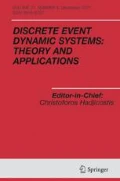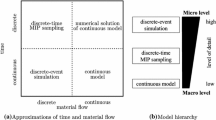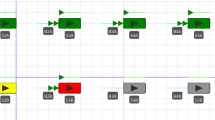Abstract
This paper addresses the performance evaluation and optimization of continuous flow transfer lines composed of two machines separated by a buffer of finite capacity. Machines are subject to time-dependent failures. Times to repair and times to failure of the machines are random variables with general distribution. For the purpose of performance evaluation, a set of evolution equations that determines continuous state variables at epochs of discrete events is established. Based on the evolution equations, we prove the concavity of the throughput rates of the machines and derive gradient estimators. Unbiasedness and strong consistency of the gradient estimators are proved. Finally, an design optimization problem that maximizes a concave function of throughput rate and a design parameter is addressed.
Similar content being viewed by others
References
Baccelli, F. Cohen, G. Olsder, G. J., and Quadrat, J. P. 1992. Synchronization and Linearity. New York: John Wiley & Sons.
Baccelli, F., and Mairesse, J. 1998. Ergodic theory of stochastic operators and discrete event networks, In: J. Gunawardena, editor. Idempotency, Publications of the Isaac Newton Institute, Cambridge University Press, pp. 171–208.
Brémaud, P., Malhamé, R. P., and Massoulié, L. 1997. A manufacturing system with general stationary failure process: stability and IPA of hedging control policies. IEEE Trans. Automatic Control 42: 155–170.
Buzacott, J. A., and Shanthikumar, J. G. 1992. Stochastic Models of Manufacturing Systems. Englewood Cliff, NJ: Prentice-Hall.
Caramanis, M., and Leberopoulos, G. 1992. Perturbation analysis for the design of flexible manufacturing system flow controllers. Operations Research 40: 1107–1125.
Dallery, Y., and Gershwin, S. B. 1992. Manufacturing flow line systems: a review of models and analytical results. Queueing Systems 12: 3–94.
Haurie, A., L'Ecuyer, P., and Van Delft, Ch. 1994. Convergence of stochastic approximation coupled with perturbation analysis in a class of manufacturing flow control models. J. Discrete Event Dynamic Systems: Theory and Applications 4: 87–111.
Hu, J. Q. 1992. Convexity of sample path performance and strong consistency of infinitesimal perturbation analysis estimates. IEEE Trans. Automatic Control 37: 258–262.
Plambeck, E. L., Fu, B.-R. Robinson, S. M., and Suri, R. 1996. Sample-path optimization of convex stochastic performance functions. Mathematical Programming 75: 137–176.
Shi, L., Fu, B.-R., and Suri, R. 1997. Sample path analysis for continuous tandem production lines, submitted.
Suri, R., and Fu, B.-R. 1994. On using continuous flow lines to model discrete production lines. J. Discrete Event Dynamic Systems: Theory and Applications 4: 127–169.
Wardi, Y., and Melamed, B. IPA gradient estimation for loss measures in continuous flow models, submitted, 1996.
Yan, H., Yin, G., and Lou, S. X. C. 1994. Using stochastic optimization to determine threshold values for the control of unreliable manufacturing systems. J. Optimization Theory and Applications 83: 511–539.
Author information
Authors and Affiliations
Rights and permissions
About this article
Cite this article
Xie, X. Evaluation and Optimization of Two-Stage Continuous Transfer Lines Subject to Time-Dependent Failures. Discrete Event Dynamic Systems 12, 109–122 (2002). https://doi.org/10.1023/A:1013391904853
Issue Date:
DOI: https://doi.org/10.1023/A:1013391904853




